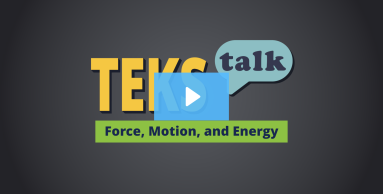
Knowledge and Skills Statement
Provide students with a toy car. Have them demonstrate for a friend a starting and stopping force. Have them explain if they used a pushing or pulling force. Next, have the students roll the car fast and then roll the car slowly. Ask them to explain to a friend how they changed the speed of the car. Finally, have the students change the direction of the movement of the car. Ask them to explain how they were able to change the direction. Students should be able to explain that pushing an object that is moving can speed it up if you push in the direction it is already going. They should also be able to explain that pushing an object in the opposite direction can slow it down or stop it. Students can also explore pulling force in a similar fashion. Pulling an object in the direction it is already going can speed it up and pulling an object in the opposite direction than it is already going can slow it down.
The further explanation is designed to be a resource for educators that helps them better understand the topic their students are learning. Further explanations may be written at a more complex level than would be expected for students at the grade level.
Forces:
When two objects interact, each one exerts a force on the other. These forces can transfer energy between the objects. When working with grade 1 students, it is helpful to understand that energy is transferred from one object to another, causing the second object to experience a change in motion. However, grade 1 students only need to know that the second object experienced a change in motion. They do not need to describe the energy transfer that caused that change.
As an educator, it is helpful to know that students will learn about the concepts of equal and unequal forces in grade 5 and will build upon that understanding in grade 6 when they apply the terms balanced and unbalanced to the concept of force. When the forces acting on an object are balanced (are equal in all directions), the motion of the object does not change. When the forces acting on an object are unbalanced (unequal in one or more directions), the motion will change, for example, by changing speed or direction.
Research
"Wilcox, Jesse, Naryah, Moore, Sarah Nolting, Courtney Reyna, and Caitlyn. “Don’t Force It! Using Guiding Questions to Scaffold Kindergartner’s Thinking of Pushes And Pulls.” Science and Children 59, no. 2 (2021): 33-37.
www.nsta.org/science-and-children/science-and-children-novemberdecember-2021/dont-force-it."
Summary: Teachers need to use questioning strategies, and this article gives examples of how to do so when teaching the concept of push and pull. It states that teachers should avoid using "yes" or "no" questions instead of focusing on using age-appropriate open-ended questions. Physical examples are important when presenting a push-and-pull activity, specifically using everyday examples, like children playing with sleds. Probing questions can help students predict what will happen and what will make an object move faster or slower. Teachers should have students predict what will happen if different variables are changed. Asking effective questions can help students generate ideas about force and motion.
